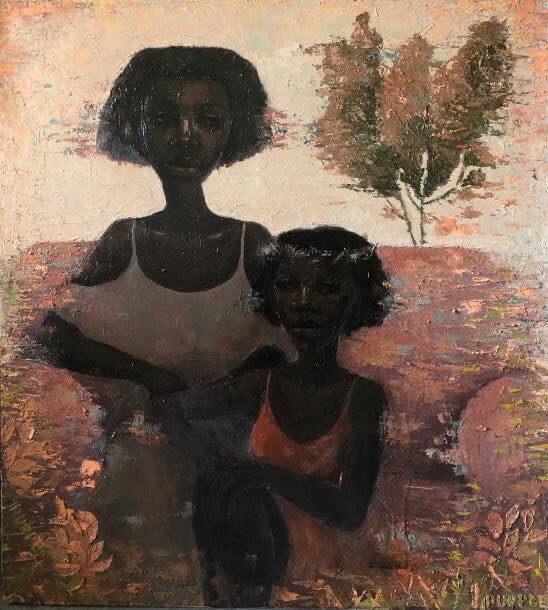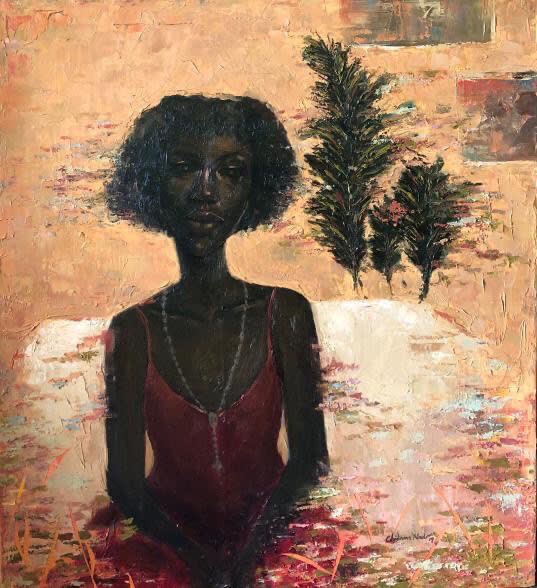CHIDINMA NNOLI
@CHIDINMA.NNOLI
Don’t you just LOVE finding a new artist whose work you just can’t get enough of? That’s exactly how I felt when discovering the works of Chidinma Nnoli!
Chidinma’s work, painted predominantly in oils, confronts entrenched structures in our society, including the patriarchal power structure and misogyny. Her work as a visual artist challenges stenotypes, psychology and the cultural conditioning of women.
I can’t stop looking at her works. There is such intimacy and powerful seclusion in each piece, the natural landscape permeates the confines of the rooms Chidinma narrates.
Chidinma EXCITINGLY has her amazing solo show ‘To Wanter Untamed’ with @relegallery THIS SATURDAY! Make sure to check it out.
-
INTERVIEW
M:
So, tell me Chidinma, what are you exploring in your exhibition with Rele gallery? Is it a new body of work?C:
It is an entirely new body of work. It's an extension of the series I did last year 'My name is Purple'. I was exploring personal experiences, like, growing up in a Catholic home, and how that environment was sort of stifling and toxic and how that affects the psychology of a growing child and I used family portraits to do that. So, moving forward with this new body of work, I just want to explore what it was like growing up, and how I felt like I was stuck in a box. Sometimes I write poems and bits and pieces of these poems inspire my work. So a poem I wrote at 8, or 17 inspired this series. It was about being in a box, and I couldn't get out of this box.
With this series I’m exploring what it’s like in that box and how to escape that box. I'm basically recreating that box-like environment that felt stifling and choking. So, in portraying that, I painted windows. The viewers are gonna be looking into someone else’s (my) life, almost like your standing directly outside their windows. So, you are seeing these subject, seeing their pain, fear and anxiety and as you progress through the body of work you see the escape and liberation. The series is a journey, almost like a coming of age story The title of the exhibition is 'To Wander Untamed'. A journey towards finding yourself, finding feminism and solace in women on that same journey.You have to look at the exhibition from a certain point and as you progress, you see the paintings open up and see the subjects owning, finding and freeing themselves. It doesn’t end you're still on that journey. Still growing.
M:
I love that, and how the journey carries on after the work too.
C:
Yeah, I don't think that ever stops because everyday you just keep discovering things about yourself that you did not know existed. I just want people to understand that journey. I feel like it's something that a lot of people would understand. In Nigeria, where I'm from, an extremely religious environment, breaking out of that status quo is something I feel that a lot of people can relate to.
M:
So, throughout your upbringing, have you always found solace in your artwork and your writing?
C:
Yeah I used to draw flowers a lot. Mostly motifs cause I wanted to be a textile designer and then I went to uni and liked painting better. I found solace in drawing nature and writing . Writing was an outlet for me at a time where I did not know how to find myself within my paintings. I haven’t written anything in a long time which is sad cause I once had a blog for it. now, painting is that outlet for me.
-
M:
And I've read before that your titles often come from that writing?
C:
Yeah. Most titles come from my writings, like, 'My name is Purple', series was inspired by a poem titled purple. Purple means pain, the colour of bruises. Sometimes I title my works in Igbo, I am Igbo, so I get them from Igbo words that are personal - so personal, you can't entirely explain what it means in English
M:
Your first body of work was so incredibly personal, is this new body still as self-reflective and person? Or broader?
C:
It's still very personal because there are various pieces that are self-portraits. You have to view the paintings in a certain order and in every stage of those works there are individual self-portraits of transition, me finding freedom and finding other women that are on the process, on the journey of finding freedom too. “To wander untamed” is broader because unlike “my name is purple“ which was strictly about family, this series combine my family, my sisters, my friends and women who inspire me.
M:
So, talk to me a bit about the outfits and clothes the figures in your works wear?
C:
I like puffy sleeves. I like big shirts, puffy sleeves, you know, those items. I just put them in my work. They look sort of vintage, and that's a good thing because I look a lot at Renaissance, and classical paintings. The fashion then is kind of the type of fashion we have now that has evolved. Puffy sleeves are back. They fit the subject's environment and adds character. Sometimes specific type of clothes are deliberate.
M:
That's wonderful. And those clothes often have this gorgeous pink colour that is present in a lot of your pieces, in the clothes, the flowers and more. Can you tell me a bit about your palette?
C:
I like having strong emotion in my work. Before, I was painting chiaroscuro, intense dark, and intense light with earth tones, browns, reds and yellows. I had Mentored with an artist, an older artist, and he painted like that - the chiaroscuro - it rubbed off on me and I wanted to get out of that style so I went the opposite way by using bright colours and i somehow found a way to maintain the emotion in my work. pastels and greys were just perfect for the somber atmosphere I was looking for.
-
M:
Did you work with your Mentor for a long time?
C:
I had one artists workshop weekend. The experience was great and the impact was huge. However, subconsciously, when you admire someone, you start looking at their works and it reflects in your work and I did not want that. I wanted my own thing, so I explored by putting together different elements I liked into one piece; texture, flowers, stencils and other things. I said earlier I wanted to be a textile designer and that’s because I was influenced by my high school art teacher who is a textile designer and was super supportive of my work back then. Stencils just made a whole lot of sense in my work and my process so I stuck with it.
M:
Which bits of your work do you stencil?
C:
Sometimes I use them for texts and other times to create floral shaped motifs with them for the backgrounds.
M:
I've seen your studio, which looks amazing! What is a daily routine for you? What does a normal day look like for you?
C:
I work mostly at night. In uni I did not have time to paint during the day because of classes. I did that for four years. It became my routine! So, I work at night and I sleep or do random things throughout the day. I start working at about 10pm to 4am. It’s just more quiet and peaceful with just you, your music and your art at night.
M:
So, what is the music you listen to?
C:
Lana Del Ray, Lorde, Kaleo, Florence + the machines..... I like soft rock and sometimes just soft instrumentals. Recently, Taylor Swift's Folklore album...
M:
And what is your process from initial idea to final painting? Do you do preliminary sketches, do you photograph?
C:
I like to move my figures around and make individual sketches of environments and figures, Not perfect sketches, just quick, immediate sketches so the idea isn’t lost. I sketch how I want the environment to look, individual objects and subjects, then I try to figure out how they can fit together during the process of painting. Sometimes it doesn't work, you know, everything changes when I start painting.
M:
How long does your process usually take? Are you a fast painter?
C:
I like to take a lot of breaks when I paint, just for myself or to observe the work. I usually make two paintings in one month. I don't want to rush myself. Recently I have had to work longer hours and create more regardless I don’t force anything. I leave them If I’m not feeling it. I look at them for a long time,When it's not working I sometimes turn it over cause I get angry seeing it, angry that I'm not getting it. Then when I do decide to work on it, I like the outcome so much and I'm grateful for not forcing it.
-
M:
And when your work sells, do you feel sad to lose it? Or are you pleased it's gone to someone?
C:
At the moment, I'm questioning why people buy my work. I want to make sure people are buying it because they actually love it and not to flip or because there’s a hype. I’m happy when people acquire them but I have a lot of questions. Some pieces I like too much, I keep for myself. But if I want to sell it, I want to be sure it's going into a good collection or an institution. so far, I’ve kept most pieces I like too much.
M:
Do you collect artwork yourself?
C:
Yeah, I started last year. I've collected 5 artists now. I just got one yesterday.
M:
That's really nice way to be able to support other artists like that. It's really important that artists are supported of course. Do you have any advice for emerging artists that you would give?
C:
It's a very tricky one, because the artworld is tricky. I think the advice I would give is don't lose yourself. It's easy to get caught up in the hype. And then I think you unconsciously start competing and painting for people other than yourself.
M:
It's very good advice. Very, very good advice. So, we said about how the artworld is tricky... but has your experience been vastly positive? Or not?
C:
I would say I'm lucky. Yeah. Because I got signed by a gallery pretty early and that just took a lot of stress off of me because dms and email inquiries on my art were distracting and I try to prioritise, work over everything else. And I'm glad that I did not have to face the art world alone, working with a gallery that is super supportive of my work is great and a huge relief because when I hear stories, I can't believe how much artists out there are being exploited.
M:
You mention DMs, do you think social media has had a big impact on your practice?
C:
Yeah, social media has a lot. In a positive way. There are some negatives, but mostly positive. It's been good for pushing my art and has helped reach collectors and galleries. social media has made it a lot easier to advance your career. It's important to take breaks. Especially off Twitter, there are arguments, misogyny, sexism, homophobia... You don't want to keep feeding your mind negatively.
M:
And so, my final question, is who are your favourite practicing female identifying and non-binary artists?
C:
Cecily brown
Zanelle muholi
Yadichinma Ukoha-Kalu
Lyunola Sanyaolu
Nengi Omuku
M:
Did you have anything else you wanted to say?
C:
The last thing.... you know how Nike says "Just do it" - yeah, just create. Forget everything else. Forget the hype. Just create. Just paint.







